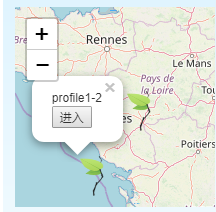版权声明:本文为博主原创文章,未经博主允许不得转载。 https://blog.csdn.net/acoolgiser/article/details/84641290
首先效果图:
这里在弹框的文字下面添加了一个button按钮和超链接。这种效果在web应用中很常见。所以下面总结一下如何用leaflet实现。


首先要用leaflet实现弹框的效果(如下图),这个就不详细介绍了,比较简单,参考leaflet官网:https://leafletjs.com/index.html
或者这里介绍一个可以在线运行示例的很棒的学习工具 https://jsfiddle.net/5apzcqvu/18/

大概的代码如下:
<template>
<div class="" title="">
<l-map">
<l-tile-layer :url="url"></l-tile-layer>
</l-marker>
<l-popup :content="name"></l-popup>
<l-marker :lat-lng="marker"></l-marker>
</l-map>
</div>
</template>
<script>
import { LMap, LTileLayer, LMarker, LPopup } from 'vue2-leaflet';
export default {
components: {
LMap,
LTileLayer,
LMarker,
LPopup
},
data () {
return {
options:{
zoom:10,
center: [47.413220, -1.219482],
minZoom: -11,
attributionControl: false
},
url: 'http://{s}.tile.osm.org/{z}/{x}/{y}.png',
marker: L.latLng(47.413220, -1.219482),
name: 'Contact1'
}
}, /*end of data()*/
methods: {
},
};/* end of export */
</script>
重点:如何添加超链接和按钮标签?
只需要在popup组件的content属性里面设置即可,注意不是直接在vue的模板template里的leaflet组件里面加 ,即:
<l-popup :content="name<br><button>进入</button>"></l-popup>
而是在script代码里面的属性设置的地方添加。即:
name: 'Contact1<br><button>进入</button>'
个人觉得原因是html的标签要在script中才能被浏览器解析。